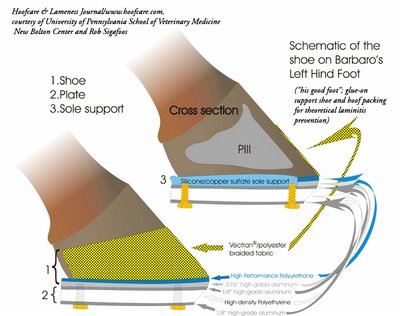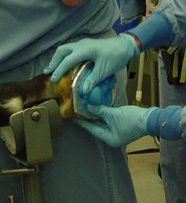"As a result of the validation of both (these) courses, farriery is now recognized as a true profession alongside Doctors, Lawyers, Accountants and, heaven forbid, even Veterinary Surgeons" writes Myerscough College Senior Farriery Lecturer Mark Caldwell.
Big news from England this week. Myerscough College and the University of Lancashire have announced a new program in advanced farrier science. The education system is a bit different in the UK, as compared to the USA, but this program will be open to US students and will also have some distance-learning components. It will be designed to prepare farriers to pass thet Worshipful Company of Farrier's Associates test, which is their mid-level of advanced farrier, followed by the Fellowship.
We are waiting for the official paperwork on the course structure from the unversity.
First of all, Mark says that there is no other program like this, anywhere in the world. "There is an amendment being put through UCLAN academic standards for the BFSc; this is available to USA students from September 2007, subject to qualification and the completion of bridging modules." he wrote to
Hoofcare & Lameness in an email on 24 May. He is interested in collaborating with farrier education programs in the USA and other countries. "We are hoping to recruit some students from the USA and the practical sessions will be conducted during a month-long summer-type school," he writes.
Here are some main points about the course, which Mark has also posted on web sites in the UK:
1. The honors degree course, which includes the foundation degree, has been set up in conjunction with University of Central Lancashire as a modular route to the Worshipful Company of Farriers (WCF) higher examinations. Both courses have had the benefit of external academic advice from the WCF and are in fact supported whole heartedly by the WCF.
2. The content of both courses has been written by the course team which includes myself, Neil Madden FWCF and Major J. Reilly PhD, BVSc, MRCVS and has followed the WCF higher examination syllabi.
3. The foundation degree is a distance learning course incorporating periodic college attendance (currently 2 days per month during college semesters) and encompasses anatomy and physiology, equine biomechanics, pathology of diseases, dynamic gait analysis, teaching and assessing, lameness evaluation and diagnostic imagery, employment and health and safety regulations pertaining to small business as theory modules delivered through on-line format. Practical subjects, including shoemaking, shoeing for pathological diseases, farriery protocols and shoeing with modern materials, are taught during the monthly workshops on campus.
4. The honors degree includes a double dissertation module (10,000 words), corrective farriery for juveniles, verification and examination techniques and business planning modules.
5. All modules are assessed in part by course work and substantively by end-of-module examination. These examinations follow closely those currently set by the WCF with the final practical examination (similar in format and content) monitored by WCF examiners.
6. All examinations will have written mediation monitored by the university academic approvals body which includes two technical advisors from the WCF
7. Both the foundation degree and honors degree are validated by the university academic standards committee and have the approval of the WCF. Both courses allow the candidate, subject to the pass grade of 60%, to apply to the WCF for either the AWCF, in the case of the foundation degree, or the FWCF in the case of the honors degree in the same way as the current military B2 or B1 allow for the diploma and associate awards. Candidates that fail to reach the 60% mark will have to sit the WCF examination separately.
8. Both courses are designed with the express intent of maintaining the WCF integrity as guardian of the standard of craftsman ship whilst recognizing the science of farriery on a formal academic basis in line with the veterinary profession.
9. The foundation degree is only open to registered farriers who hold the WCF diploma or recognized equivalent, currently the American Farriers Association CJF. The honors degree will only be open to holders of the foundation degree or WCF Associate award. Those students only holding the associate award will be required to undertake 4 bridging modules before starting the honors degree in order to prepare them for the academic rigor of level 3 degree study.
More details are available in Hoofcare & Lameness Journal, issue #80. No link to further information is currently available via the Internet.Learn more about the art and science of the horse's hoof in our journal (and subscribe online using our secure server) and on our website at http://www.hoofcare.com or write to Hoofcare Publishing, 19 Harbor Loop, Gloucester MA 01930 USA. Tel USA 978 281 3222; Fax 978 283 8775, or email fran@hoofcare.com







